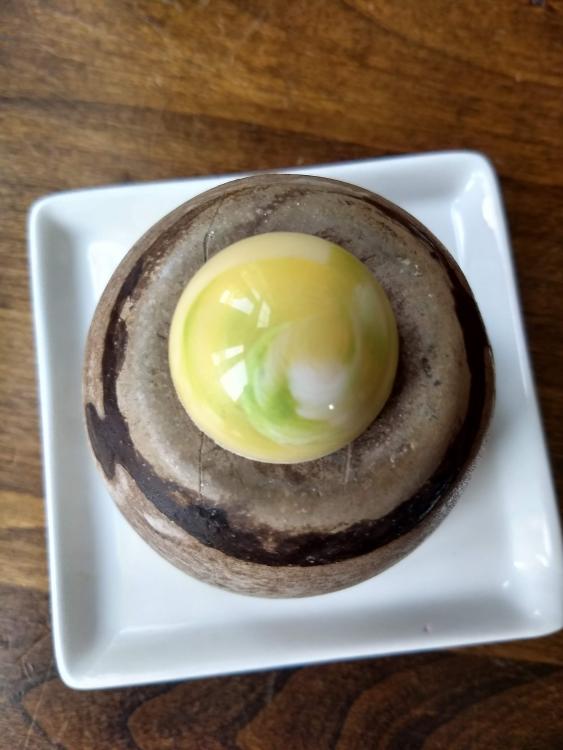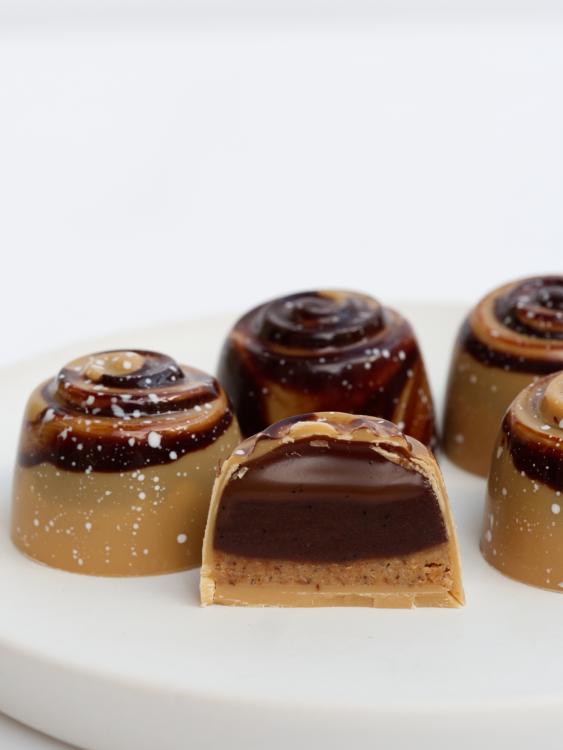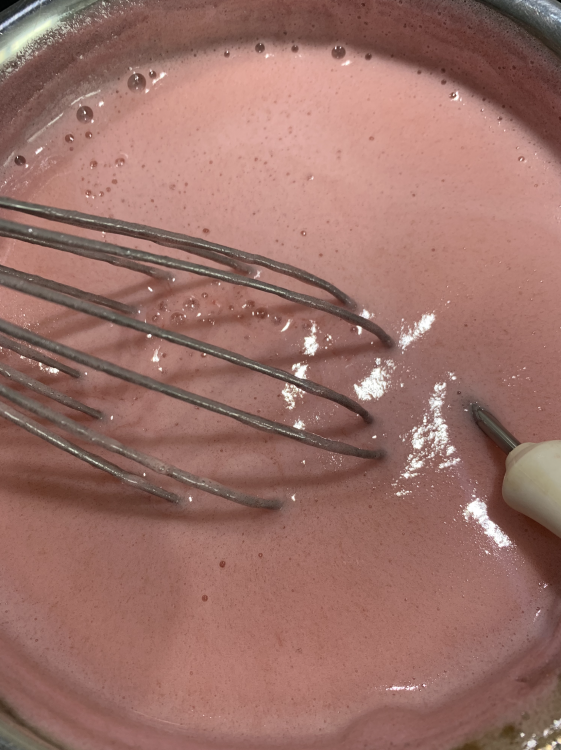
Rajala
-
Posts
625 -
Joined
-
Last visited
Content Type
Profiles
Forums
Store
Help Articles
Posts posted by Rajala
-
-
2 minutes ago, Jim D. said:
I have performed the experiment once more and am getting what one might call a "consistent inconsistency." I made Wybauw's pear recipe (Fine Chocolates Gold, p. 309). The Aw reading immediately after the ganache was piped was 0.78. Approximately three hours later, the same sample produced a reading of 0.64. For someone who is quite cautious about shelf life issues, these readings are very good news.
This is so strange. It feel like it's dropping way too much. I'm currently talking with people working with these kind of things for a project of mine. I have to ask them about this.
How do you store the sample for those three hours?
-
So, I'm back making some tarts with all the nice berries now available. I have a problem with some tarts not releasing from the mould (almost sounds like I'm talking about chocolate here?). Am I overworking the dough? What can be the cause of this? Million things of course, but maybe there are things that are more common than others?
-
My kitchen is 29,5°C at the moment. Maybe I should try make some bonbons? 😅
-
 1
1
-
-
I've made some experiments with heating the moulds and I don't really notice any difference. Maybe it could be an issue if you're working space is really cold? Like 18° or so? Not sure. But I don't get more glossy chocolates by heating the mould before moulding.
-
I found a way to buy some, but it was a whole pallet of ~450 kgs. A little bit too much.
But I solved this in a different way, someone helped me and will ship from US.
-
 1
1
-
-
That's a nice looking unit!
-
On 4/10/2021 at 1:55 AM, jimb0 said:
it’s been a while since i looked at greweling and i haven’t read notter. i’m curious as to how they came up with these ranges and whether there’s any reasoning given for them.
i can imagine that chocolate stored very cool or frozen will condense moisture on its surface if not properly brought up to temp. similarly, cold can both inhibit flavour release, and for chocolates with a lot of cocoa butter, cause textural issues.
yet to my mind those are not necessarily always going to be reasons not to keep chocolates or bonbons at very cold or frozen temperatures (obviously many in this forum do just that with seemingly few to no ill effects).
From what I gather it's also that the chocolate have the best taste at these temperatures. I don't think that cold is a problem per se, we know that there are companies that freeze their bonbons and thaw them later in the right conditions to prevent sugar bloom and fat bloom which also can occur under temperature fluctuations.
-
4 hours ago, Jonathan said:
It’s been a while but turns out he WAS using toffee: Here. You can see the steam/crack afterwards, sorcery!
Haha nice update. Yeah, it's something hot there, that's for sure.
-
Looking good Jim! I like the approach with Orelys.
-
Seems really hard to find these malt balls in Europe? Anyone from Europe lingering around that know where you can source these?
-
24 minutes ago, Kerry Beal said:
Pre made - they are made in a vacuum process that can’t be duplicated at home - Ask me how I know!
In North America we buy them from Nuts.com Or some other company the name of which escapes me.
How?

Okay, I should probably just try to ask some local vendors if they can source it or so. I have no idea what they are called in Swedish, maybe a part of the problem.
-
 1
1
-
-
I've been thinking of these malted milk balls or maltballs or whatever we want to call them. Can you buy these pre made and then coat them or do you make them yourself? My google skills are failing my brutally on this subject.
-
4 hours ago, Sweet Impact Mama said:

I really like this style.
-
 1
1
-
-
Second attempt went better. I still want to understand what went wrong with the first one though.

-
4 minutes ago, Jim D. said:
Looks delicious. And the decoration nicely suggests the contents. Another of your specialty multi-layered bonbons. So can you reveal the contents? Some cinnamon ganache?
There's cinnamon there for sure. Top layer is a caramel with browned butter and vanilla. Middle layer is a ganache made out of milk and dark chocolate with more browned butter, cinnamon, and vanilla as well. Bottom layer is the crispy part with Zéphyr caramel, browned butter, some extra cocoa butter, coconut oil and cinnamon bun crusts (not sure what to call it really), but they sell like dried cinnamon buns at the local store, so I just crushed them to pieces and blended it in.
-
 1
1
-
 1
1
-
 1
1
-
-
-
9 minutes ago, Jim D. said:
I made a rhubarb PDF recently, using both commercially made rhubarb purée and some fresh rhubarb I purchased locally. I was using Pomona's pectin. Mine turned out without any issues such as yours. Since commercial purées (like Boiron) are used for PDF a lot, I don't understand what happened to yours. As rhubarb is low in natural pectin, you may have to use more pectin powder (or add another fruit, such as apple or pear, to provide pectin). In regard to the rhubarb strings, I have not found that to be a problem. If it is cooked long enough, they more or less dissolve. You could always use an immersion blender to smooth it out.
Yeah, it's super strange. I dunno what happened. I bought some more rhubarb now and will try again with all of it and run it with the immersion blender as you suggest.
-
I planned to make a rhubarb "PDF", and this happened? Any ideas? The only think I can think of is that the rhubarb reacts with pectin some how, but like what? Everything just turned foamy. With that said, I just used the juice of the rhubarb and guess that plays part in this. I don't want the texture of all the "threads" in the rhubarb in my PDF. Don't have store bought purée at the moment.
-
I'll join in with the rest here. I never work above 23°. It's currently 24° in the kitchen, so my rhubarb bonbon making need some AC help.
-
I'm not sure, but with that said, I find the min cocoa % strange. The data I have say that Ruby contains 29,5% cocoa butter and 4,5% cocoa mass.
-
What would you say is a normal amount of time it will take to temper 1 kg with the seeding method?
-
15 hours ago, Altay.Oro said:
If there is enough water in the environment to emulsify with oil molecules ... can there be any reason other than the shortage of emulsifier for the failure to emulsify?
For example ... when making a low ratio chocolate ganache (1:1 with milk chocolate or even less chocolate), have you ever experienced a difficulty in emulsfying chocolate with cream?
I've done 1:1 with chocolate and cream, no problems. I guess the lecithin found in most chocolate will help with that as well. The AW reading is out the roof though.
-
 1
1
-
-
Looks great. I guess the black part is color in powder form? You gave me some inspiration for some upcoming "designs" - I have 30 recipes that needs some coloring. 😂
-
Yeah, it's the very same mould many thought it was. The picture of the moulded chocolate on Chocolate Worlds website depicts another fish though, so it's really weird.



Water Activity/Shelf LIfe
in Pastry & Baking
Posted
I missed that, sorry. Yeah, but like leaving them i the open will definitely cause it to dry out a bit. Question is like how much the "dry" surface will affect any readings. Well, I'm going to talk with someone about this later, someone who's expertise is food safety. She will know more than me for sure.